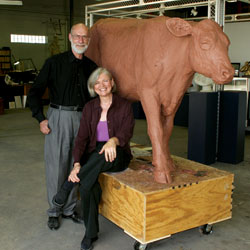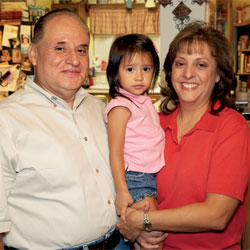I am about to embark on the decluttering project(s) to end all decluttering projects.
According to Julie Morgenstern in Organizing from the Inside Out, this means creating a system based on my specific personality, needs and goals. It focuses on defining who I am and what is important to me as a person so that my system is designed to reflect that.
I tended to think that I was the only one who lived among clutter — the clutter of my home, the clutter of my office, my car, etc. I have also understood that although I have an organized mind, my surroundings have been something else. I have since learned that this is a very common affliction. So if you’re feeling inadequate because of your clutter, we are not alone!
Years ago, after reading Simple Abundance by Sarah Breathnach, I managed to make my bedroom a place of orderly beauty, and with minimal effort (and a weekly home-cleaning crew), it stays that way. One of Breathnach’s recommendations is to throw away everything that isn’t beautiful, valuable or sentimental. I did that in the bedroom, and I have started doing that in the rest of the house. It’s a slow process.
Several of my patients have told me about a growing pile of clothing on a chair, a chest of drawers (as a child, I heard it as “chester drawers”) or other piece of furniture. The bigger it gets, the more intimidating it is. When I finally drag myself to bed at night, I do peel off the day’s clothing and drape it on a chair by my dresser. And in the morning, I faithfully put it in its proper place. I don’t want to leave the room disheveled. I fear it will deteriorate immediately. That’s the attitude I want to generalize to the rest of my spaces.
Morgenstern recommends starting with an analysis of internal processes. What stops you from getting started and keeping it going? She offers three levels of possibilities:
Technical Errors — items have no home; inconvenient storage; more stuff than storage space; complex, confusing system; out of sight, out of mind; organizing is boring.
External Realities — unrealistic workload; speed of life/technology; in transition; uncooperative partners; limited space.
Psychological Obstacles — need for abundance; conquistador of chaos; unclear goals and priorities; fear of success/fear of failure; need to retreat; fear of losing creativity; need for distraction; sentimental attachment; need for perfection. (I add Obsessive Compulsive Disorder: hoarding.)
She goes into detail in her book about remedies. I spent some time on this and recognized that, for me, it’s a combination of technical errors and external realities. I have way too much “stuff,” and a lot of it is junk mail that I haven’t sorted through and tossed. Much of the rest of it is outdated information in file folders. Also, I put too many activities in each day and run out of energy before I can get them all done.
Before starting, analyze. Figure out where you are and what you want to accomplish. I started with my work space in our family room. Before rushing to the Container Store to buy various organizing tools, I planned, with Morgenstern’s guidance, what I will put in the space: She recommends the kindergarten model of organization. I used a marker board and stick-it notes (the 5-by-6-inch ruled ones). Each note represents a space in the family room. On the note, list what’s needed for that activity.
For my work space I need my chair, a table for the laptop computer and telephone, lap insulators to protect my lap from the heat generated by the computer, my external hard drive, cables to connect to the printer, hard drive, scanner, etc., surge protector for the power cable for the external drive and the computer, a small table for my immediate to-do items (letters to be answered, bills to be paid, etc.) A wooden compartmentalized “organizer” for pens, computer program CDs, to-do items that aren’t immediate, etc. Also, a small file on rollers for folders I’m working with. It can be rolled into the study when I’m not using it, or into the “Harry Potter closet” under the stairs.
When I started, there were four stacks of papers, magazines and books on the tables near my workplace, the coffee table and the hearth. The greatest idea I got from Julie was to buy a box to hold things I don’t want to spend time on now, and that I know I want to review further before I decide whether to throw them away or file them.
I found a great collapsible file box, on wheels, at Office Depot. I liked it so much I bought a second one for my office. As I sorted through the four piles, I had four places to sort into: The little table by my chair for immediate to-dos. I did not let myself stop and do them. I stayed on task. The organizer for the longer-term to-dos, the garbage bag(s) for throw-aways, and the black file box for “further consideration.”
Morgenstern gives the following acronym, SPACE:
Sort
Purge
Assign a home
Containerize
Equalize
It took me about four hours to get all of the sorting, purging and assigning done. One of the things Morgenstern focuses on is making a realistic estimate of the time needed for each project. She offers some guidelines for several projects. For a home office, the sorting takes 16 to 18 hours (mine was much less because I put the major task into that storage box for further sorting later); purging, three hours; assigning a home, one hour; equalizing (this is the process of updating on a daily basis, making changes to the system as necessary and incorporating new items, such as daily mail, in the system), three to five minutes every day. For the purging she recommends throwing away everything that isn’t beautiful, sentimental or will make you money.
In order to make this process REALLY work, I will discipline myself to spend an hour each Friday on that black box. I recognize that this will take several months to complete. I’m starting with my work space, then the study. Meanwhile, I’m working on my real office an hour or two at a stretch, using the black box to store stuff until I can get back to it.
Author: Rosemary J. Stauber









0 Comments